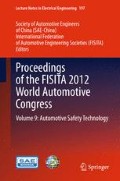Abstract
When drowsiness detection is unreliable or absent, conventional on-demand driver vigilance enhancement approaches become ineffective. We propose a new, detector-free method to provide an alert signal to a driver in this case. Its unique triggering mechanism is based upon our hypothesis that as one becomes sleepy, his pain threshold lowers and an otherwise below-threshold stimulation becomes painful. We use the pain illusion phenomenon to construct a user-tailored innocuous thermal alert signal, to be triggered only by a host’s own declining vigilance state, to produce a noxious response. This response will serve to arrest and eventually raise the host’s arousal, when noxious sensation would disappear completely, automatically. In this paper, we present the design rationale, prototype instrumentation and preliminary findings from testing this hypothesis.
F2012-F07-003
Access this chapter
Tax calculation will be finalised at checkout
Purchases are for personal use only
References
Borbély AA (1982) Two process model of sleep regulation. Hum Neurobiol 1(3):195–204
Van Dongen HPA, Dinges DF (2000) Circadian rhythms in fatigue, alertness and performance. In: Kryger MH, Roth T, Dement WC (eds.) Principles and practice of sleep medicine. WB Saunders, Company, Philadelphia, pp 391–399
Carskadon MA et al (1986) Guidelines for the multiple sleep latency test (MSLT): a standard measure of sleepiness. Seep 9(4):519–524
Dorrian J, Rogers NL, Dinges DF (2005) Psychomotor vigilance performance: neurocognitive assay sensitive to sleep loss, in scientificcommon,
Rajaraman S et al. (2012) A new metric for quantifying performance impairment on the psychomotor vigilance test, J Sleep Res
Abe T et al (2011) Detecting deteriorated vigilance using percentage of eyelid closure time during behavioral maintenance of wakefulness tests. Int J Psychophysiol 82(3):269–274
Shirakata T, Tanida K (2010) Detect the imperceptible drowsiness. SAE Int J Passeng Cars-Electr Electr Syst 3(1):98–108
McAlonan K et al (2006) Attentional modulation of thalamic reticular neurons. J Neurosci 26(16):4444–4450
Crick F (1984) Function of the thalamic reticular complex: the searchlight hypothesis. PNAS 81(14):4586–4590
Craig AD (2003) Pain mechanisms: labeled lines versus convergence in central processing. Annu Rev Neurosci 26:1–30
Taylor KS (2009) at al. Two systems of resting state connectivity between the insula and cingulate cortex. Hum Brain Mapp 30(9):2731–2745
Eckert MA et al (2009) At the heart of the ventral attention system: the right anterior insula. Hum Brain Mapp 30(8):2530–2541
Dhaka A et al (2006) TRP ion channels and temperature sensation. Annu Rev Neurosci 29:135–161
Gelfand S (1964) The relationship of experimental pain tolerance to pain threshold. Can J Psychology/Revue Canadienne de Psychologie 18(1):36–42
Onen HS et al (2001) The effects of total sleep deprivation, selective sleep interruption and sleep recovery on pain tolerance thresholds in healthy subjects. J Sleep Res 10(1):35–42
Kundermann B et al (2004) The effect of sleep deprivation on pain. Pain Res Manag 9(1):25–32
Lydic R, Baghdoyan HA (2005) Sleep, Anesthesiology, and the neurobiology of arousal state control. Anesthesiology 103:1268–1295
Thunberg T (1896) Förnimmelserne vid till samma ställe lokaliserad, samtidigt pågående köld-och värmeretning. Uppsala Läkfören Förh 1:489–495
Craig AD, Bushnell MC (1994) The thermal grill illusion: unmasking the burn of cold pain. Science 265(5169):252–255
Green BG (2002) Synthetic heat at mild temperatures. Somatosens Mot Res 19(2):130–138
Bouhassira D et al (2005) Investigation of the paradoxical painful sensation (‘illusion of pain’) produced by a thermal grill. Pain 114:160–167
Li X et al (2009) The importance of stimulus parameters for the experience of the thermal grill illusion. Neurophysiologie Clinique/Clinical Neurophysiol 39:275–282
Peltz E et al (2011) Functional connectivity of the human insular cortex during noxious and innocuous thermal stimulation. NeuroImage 54:1324–1335
Lindstedt F et al (2011) Evidence for thalamic involvement in the thermal Grill Illusion: an fMRI study. PLoS ONE 6(11):e27075
Tseng MT et al (2010) Distinct and shared cerebral activations in processing innocuous versus noxious contact heat revealed by functional magnetic resonance imaging. Hum Brain Mapp 31:743–757
Neziri AY et al (2011) Reference values of mechanical and thermal pain tests in a pain-free population. Eur J Pain 15:376–383
Raymann RJE et al (2005) Cutaneous warming promotes sleep onset. Am J Physiol Regul Integr Comp Physiol 288:R1589–R1597
Vierck CJ et al (1997) Characteristics of temporal summation of second pain sensations elicited by brief contact of glabrous skin by a preheated thermode. J Neurophysiol 78:992–1002
Woolf CJ et al (2000) Neuronal plasticity: increasing the gain in pain. Science 288(5472):1765–1768
Banks S, Dinges DF (2007) Behavioral and physiological consequences of sleep restriction in humans. J Clin Sleep Med 3(5):519–528
Lindstedt F et al (2011) Perception of thermal pain and the thermal grill illusion is associated with polymorphisms in the serotonin transporter gene. PLoS ONE 6(3):e17752
von Hehn CA, Baron R, Woolf CJ (2012) Deconstructing the neuropathic pain phenotype to reveal neural mechanisms. Neuron 73(4):638–652
Author information
Authors and Affiliations
Editor information
Editors and Affiliations
Rights and permissions
Copyright information
© 2013 Springer-Verlag Berlin Heidelberg
About this paper
Cite this paper
Chang, S. (2013). On-Demand Driver Vigilance Enhancement Without Drowsiness Detection. In: Proceedings of the FISITA 2012 World Automotive Congress. Lecture Notes in Electrical Engineering, vol 197. Springer, Berlin, Heidelberg. https://doi.org/10.1007/978-3-642-33805-2_38
Download citation
DOI: https://doi.org/10.1007/978-3-642-33805-2_38
Published:
Publisher Name: Springer, Berlin, Heidelberg
Print ISBN: 978-3-642-33804-5
Online ISBN: 978-3-642-33805-2
eBook Packages: EngineeringEngineering (R0)

